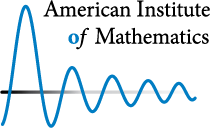1. Estimates for $\overline{\partial}$
-
Problem 1.1.
[Varolin] Let $\Omega$ be a pseudoconvex domain in $\mathbb{C}^n$ that contains $0$ and let $\phi\in L^1_{loc}(\Omega)$ be a weight function on $\Omega$. Let $H$ be a hyperplane through $0$ and $f$ be a holomorphic function on $H\cap\Omega$ such that $$\int_{H\cap\Omega}|f|^2e^{-\phi}dV<\infty.$$ Suppose that for some constant $C$, $$i\partial\overline{\partial}\phi\geq -Ci\partial\overline{\partial}\log B_{\Omega}(z,z)$$ where $B_{\Omega}(z,z)$ denotes the Bergman kernel of $\Omega$ on the diagonal. How big can $C$ be so that there exists a holomorphic function $F$ on $\Omega$ such that $$F=f \text{ on }H\cap\Omega \text{ and }\int_{\Omega}|F|^2e^{-\phi}dV\leq \int_{H\cap\Omega}|f|^2e^{-\phi}dV?$$ Is it possible to find a universal constant $C$?
$\bullet$When $C=0$, this is the Ohsawa-Takegoshi extension theorem (see [MR2743817]).
$\bullet$ If $\Omega$ is strictly pseudoconvex then $C\geq\frac{1}{n+1}$ works (see [MR2743817]); however, it is not known whether this is sharp.
$\bullet$ It is known that such a constant $C$ exists when the domain is convex and finite type in $\mathbb{C}^n$ or just finite type in $\mathbb{C}^2$. -
Problem 1.2.
[Dragomir] Let $\mathcal{W}$ be the smooth Diederich–Fornaess worm domain in $\mathbb{C}^2$ (see [MR0430315]) and $\rho$ be a defining function for $\mathcal{W}$. Let $g_{\rho}$ be the Kähler metric on $\mathcal{W}$ whose Kähler 2-form is $i\partial\overline{\partial}\log(-\rho).$ Study the $\mathcal{C}^{\infty}$-regularity up the boundary for the Dirichlet problem \begin{align*} \Delta_{\rho}u&=0 \text{ in } \mathcal{W},\\ u&=f \text{ on } b\mathcal{W}, \end{align*} where $f\in \mathcal{C}^{\infty}(b\mathcal{W})$ and $\Delta_{\rho}$ is the Laplace-Beltrami operator corresponding to $g_{\rho}$. Start by analyzing the pseudohermitian invariants of the leaves of the foliation given by the level sets of $\rho$ and in particular understand the geometry of the weakly pseudoconvex locus of this foliation. -
Problem 1.3.
[Catlin] Let $\Omega$ be a smooth bounded domain in $\mathbb{C}^n$ such that the automorphism group of $\Omega$ is non-compact. What can be said about $\Omega$? See [MR1706680]. -
Problem 1.4.
[Straube] Let $\mathcal{W}$ be the smooth Diederich–Fornaess worm domain in $\mathbb{C}^2$ and $\mathbf{B}_{\mathcal{W}}$ denote the Bergman projection operator on $\mathcal{W}$. Prove or disprove that $\mathbf{B}_{\mathcal{W}}(\log \overline{z_1})$ is in $\mathcal{C}^{\infty}(\overline{\mathcal{W}})$. Note that if it fails to be smooth up to the boundary then an alternative proof is obtained for the fact that the Condition R fails on $\mathcal{W}$. See [MR3130312] and [MR1370592]. -
Problem 1.5.
[Harrington] Let $\Omega$ be a smooth bounded pseudoconvex domain such that for any $0<\eta<1$, there exists a defining function $\rho_{\eta}$ such that $-(-\rho_{\eta})^{\eta}$ is plurisubharmonic on $\Omega$. Note that such an $\eta$ always exists [MR0430315]; however, it could be small. Determine minimal assumptions on $\Omega$ to show that $\overline{\partial}$-Neumann operator $N$ (or the Bergman projection operator $\mathbf{B}$) is globally regular. Determine minimal assumptions on $\Omega$ to show existence of a Stein neighborhood basis for the closure. Are there any domains such that $\mathbf{B}$ is globally regular but no such a family of defining functions exists?
Cite this as: AimPL: Cauchy-Riemann equations in several variables, available at http://aimpl.org/crscv.
